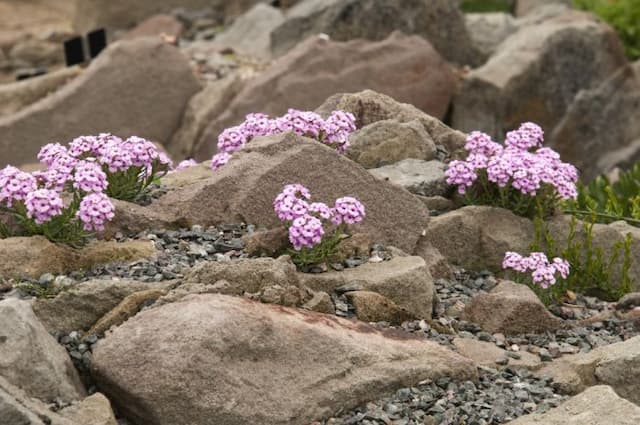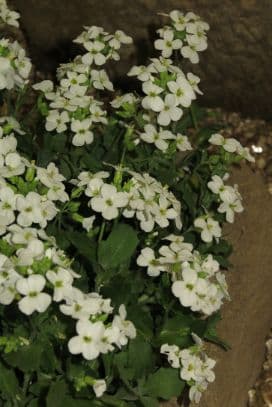Wallflower Erysimum 'Apricot Twist'

ABOUT
Erysimum 'Apricot Twist', commonly known as the Wallflower, is a perennial plant that is captivating because of its unique, vibrant flowers. The blossoms are a striking blend of warm apricot and orange hues with a subtle twist of fading color edges, appearing as if each petal has been delicately dipped in a lighter pigment. These flowers are small to medium in size and grow in abundant clusters, creating a bold display of color. The Wallflower's foliage is comprised of narrow, lance-shaped leaves that provide a lush green backdrop to the flowers, accentuating their brightness. The leaves are semi-evergreen, depending on the climate, which means they provide color and texture to the garden year-round. The overall shape of the Erysimum 'Apricot Twist' is bushy and dense, with a robust branching habit that lends itself to a full, rounded appearance. As a perennial, it adds a lasting presence in the garden, delivering a splash of apricot tones for a prolonged flowering period in the growing season.
About this plant
 Names
NamesFamily
Brassicaceae
Synonyms
Wallflower, Apricot Twist
Common names
Erysimum 'Apricot Twist'
 Toxicity
ToxicityTo humans
The Erysimum 'Apricot Twist', commonly known as wallflower, is not generally considered toxic to humans. However, like many plants, it could potentially cause mild stomach upset if ingested in large quantities. It is always wise to avoid eating ornamental plants as a precaution. There are no widely recognized severe symptoms of poisoning from this plant for humans.
To pets
The wallflower is also not specifically noted for being toxic to pets such as dogs and cats. However, pets sometimes react differently to plants, and ingestion could possibly lead to gastrointestinal upset such as vomiting or diarrhea if eaten in significant amounts. It's always a good idea to keep an eye on pets and discourage them from eating plants that are not meant for consumption.
 Characteristics
CharacteristicsLife cycle
Perennials
Foliage type
Evergreen
Color of leaves
Green
Flower color
Apricot
Height
1-2 feet (30-60 cm)
Spread
1-2 feet (30-60 cm)
Plant type
Shrub
Hardiness zones
7
Native area
Europe
Benefits
 General Benefits
General Benefits- Attractive Flowers: Erysimum 'Apricot Twist', also known as Wallflower, produces vibrant apricot-orange blossoms that add a pop of color to gardens and landscapes.
- Long Blooming Period: Wallflowers are known for having a lengthy blooming season, often from early spring through late summer, providing long-lasting visual interest.
- Fragrance: The flowers emit a pleasant scent that can enhance the sensory experience of a garden.
- Pollinator Attraction: The bright flowers of the Wallflower attract bees, butterflies, and other beneficial pollinators, supporting local ecosystems.
- Drought Tolerance: Once established, this plant is relatively drought tolerant, making it suitable for xeriscaping and lower maintenance gardens.
- Easy to Grow: Wallflowers are generally easy to care for, making them a good choice for both novice and experienced gardeners.
- Versatility: Erysimum 'Apricot Twist' can be used in borders, rockeries, containers, and as a cut flower, making it a versatile addition to various garden designs.
- Deer Resistance: The plant is often resistant to deer, which helps prevent damage in gardens where deer are a common issue.
- Compact Growth: With its compact growth habit, it is suitable for smaller gardens or tight spaces where larger plants might not fit.
 Medical Properties
Medical PropertiesThis plant is not used for medical purposes.
 Air-purifying Qualities
Air-purifying QualitiesThis plant is not specifically known for air purifying qualities.
 Other Uses
Other Uses- The Wallflower can be used as a natural dye, providing various shades of yellow, orange, or brown depending on the mordant used.
- Wallflower petals are sometimes included in potpourris for their color and mild fragrance, offering a subtle, spicy scent to the mixture.
- With its dense foliage, Wallflower can be utilized as a low border or edging plant in garden designs, providing a visual demarcation between different areas of the garden.
- The flowers can be used to create a visually appealing edible garnish on salads and desserts, though it's essential to ensure no pesticides have been used on them.
- Wallflower cuttings can be arranged in small bouquets for casual events, adding a splash of color with their apricot-hued blossoms.
- During blooming time, Wallflower can serve as a natural attractant for pollinators such as bees and butterflies, enhancing the biodiversity of the garden.
- Pressed Wallflower flowers can be included in craft projects, such as handmade cards or bookmarks, to add a touch of natural beauty.
- When planning companion planting in a vegetable garden, Wallflower may help attract beneficial insects that prey on garden pests.
- The Wallflower’s vibrant color can be used as a form of color therapy in gardens, creating an uplifting and warm environment that could potentially boost mood.
- In photography, Wallflowers can be employed as a photogenic subject or backdrop due to their attractive flowers and overall plant structure.
Interesting Facts
 Feng Shui
Feng ShuiThe Wallflower is not used in Feng Shui practice.
 Zodiac Sign Compitability
Zodiac Sign CompitabilityThe Wallflower is not used in astrology practice.
 Plant Symbolism
Plant Symbolism- Resilience: Erysimum, commonly known as Wallflower, often symbolizes durability and survival as it can thrive in challenging conditions and poor soils.
- Faithfulness: In the Victorian language of flowers, the Wallflower signifies fidelity in adversity, perhaps because it clings to walls and rocky places.
- Adversity: As a plant that grows in difficult places, Wallflower can symbolize an ability to overcome tough situations.
- Humility: Being a simple, unassuming plant, the Wallflower can represent modesty or the beauty of simplicity.
 Water
WaterThe Wallflower 'Apricot Twist' should be watered regularly, aiming for moist, well-drained soil. Water the plant deeply once or twice a week with approximately one to two gallons per plant, depending on weather conditions. During the growing season in spring and summer, water needs may increase, especially in hot, dry spells. Cut back on water in the winter when the plant is dormant, ensuring the soil doesn't become waterlogged. Always check the top inch of soil for dryness before watering to avoid overwatering.
 Light
LightWallflowers like 'Apricot Twist' thrive best in full sun to partial shade. They should be placed in a location where they receive at least six hours of direct sunlight daily. The plant will appreciate some afternoon shade in extremely hot climates to prevent scorching. Always ensure it gets enough light to maintain vibrant blooms and healthy growth.
 Temperature
Temperature'Apricot Twist' Wallflower prefers a temperate range with ideal growing temperatures between 65°F and 75°F. The plant can withstand minimum temperatures down to about 20°F but may suffer damage if the temperature drops below this point. Wallflowers can tolerate maximum temperatures up to around 85°F but should be protected from extreme heat.
 Pruning
PruningPrune Wallflower 'Apricot Twist' to remove spent blooms and encourage new growth. Light pruning can be done any time during the season to maintain shape and size; however, a more thorough pruning should be done in late winter or early spring. Regular pruning every year will help the wallflower maintain vigor and produce abundant flowers.
 Cleaning
CleaningAs needed
 Soil
SoilThe best soil mix for Wallflower 'Apricot Twist' is well-draining soil with added organic matter like compost or peat moss. The soil pH should range from slightly acidic to neutral, around 6.0 to 7.0.
 Repotting
RepottingWallflower 'Apricot Twist' typically does not require frequent repotting and can be repotted every 2-3 years or as needed when the plant outgrows its current container.
 Humidity & Misting
Humidity & MistingWallflower 'Apricot Twist' prefers low to moderate humidity levels and does not require high humidity to thrive.
 Suitable locations
Suitable locationsIndoor
Ensure bright light, minimal water, and good air circulation.
Outdoor
Plant in full sun, well-draining soil, and space adequately.
Hardiness zone
7-10 USDA
 Life cycle
Life cycleThe Wallflower 'Apricot Twist' starts its life cycle when seeds are sown into well-drained soil, ideally in early spring or early autumn. Germination occurs, and seedlings emerge as temperatures become suitable. As the plant matures, it develops a woody base with narrow, lance-shaped leaves and begins to produce fragrant apricot-orange flowers, predominantly in spring through early summer, but it can bloom until fall in some climates. Throughout its peak growth times, the Wallflower 'Apricot Twist' requires regular deadheading to encourage further blooming and maintain plant vigor. Being a short-lived perennial or biennial, after 2-3 years, or sometimes longer with proper care, the plant will begin to decline and may need to be replaced. As it approaches the end of its life, seeds can be collected for sowing or allowed to self-seed if conditions allow, continuing the cycle with a new generation of plants.
 Propogation
PropogationPropogation time
Spring-Early Summer
Propogation: The Erysimum 'Apricot Twist', commonly known as Wallflower, is best propagated by taking semi-hardwood cuttings during late summer. To do this, select a healthy stem and cut a 4 to 6 inch (10 to 15 cm) section just below a leaf node. Strip the lower leaves, leaving a few at the top, and dip the cut end into rooting hormone. Place the cutting in a pot filled with a mix of half peat and half perlite or coarse sand to ensure good drainage. Water the cutting and cover it with a plastic bag or place it in a propagator to maintain humidity. Place the pot in a warm location with indirect sunlight. Roots typically develop within a few weeks, after which the new Wallflower plant can be gradually acclimated to outside conditions and planted out.



![Aubrieta [Axcent Light Blue]](/_next/image?url=https%3A%2F%2Fplants-admin.emdemapps.com%2Fimages%2Fplants%2F%2Fimages%2F604b5e7128866.png&w=640&q=75)





